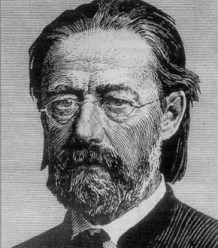Bedrich Smetana - String Quartet No.1-Piano Trio In G Minor
Bedrich Smetana - String Quartet No.1 - Piano Trio In G Minor

String Quartet No.1 In E Minor, Op.115 'From My Life'
1. Allegro Vivo Appassionato
2. Allegro Moderato A La Polka
3. Largo Sostenuto
4. Vivace
Alban Berg Quartet
Piano Trio In G Minor, Op.15
1. Moderato Assai
2. Allegro Ma Non Agitato - Alternativo I - Alternativo II
3. Finale. Presto
Amati Trio
Smetana completed the String Quartet No. 1 in E minor on December 29, 1876, at a time when he began to realize that his encroaching deafness was unstoppable. The most important aspect of the piece is its autobiographical program, making it, almost certainly, the first chamber music work of its type. It would influence Janacek in his two programmatic quartets, Kreutzer Sonata and Intimate Letters.
In a letter to his good friend Joseph Srb-Debrnov, Smetana writes: "My intention was to paint a tone picture of my life." Later, he would describe the work as "more or less a private composition, and therefore deliberately written for four instruments conversing among themselves about the things that torture me, and no more." What tortured Smetana was recurring noise in his ears and the gradual reduction in his hearing. He entitled the work, "Z mého života" (From my life), and watched the first performance of the piece, on March 29, 1879, through opera glasses from the side of the stage.
In his letter to Srb-Debrnov, Smetana claims that, "I had no intention of writing any quartet to the customary formulas, on which I worked sufficiently as a student of music theory...." This is curious, as the movements of the E minor Quartet are cast in easily recognizable forms and Smetana maintains the traditional four-movement scheme of the string quartet.
Smetana goes on: "The first movement depicts my youthful leanings toward art, the Romantic atmosphere, the inexpressible yearning for something I could neither express nor define, and also a kind of warning of my future misfortune." The movement is in sonata form, the first theme, a passionate viola melody, representing "fate's summons to take part in life's combat." The secondary theme, in G major, depicts "affection for romance in music and love." This theme is transformed just before the beginning of the powerful development. In the recapitulation, Smetana skips the return of the first theme and the transition, beginning instead with the second theme and then pursuing a relatively free course.
The second movement, Quasi Polka, is a scherzo in a polka rhythm with fugal passages, depicting "the joyful days of youth when [Smetana] composed dance tunes and was known everywhere as a passionate lover of dancing." Its atmosphere evokes the opening of the overture to The Bartered Bride.
Of the third movement, Largo sostenuto, Smetana remarks: ..."[it] reminds me of the happiness of my first love, the girl who later became my faithful wife." The movement is organized as a set of variations on two melodies with interpolated episodes.
"The long, insistent note in the finale...is the fateful ringing in my ears of the high-pitched tones which, in 1874, announced the beginning of my deafness." Smetana represents this ringing with a sustained, high E natural in the coda, preceding reminiscences of the first two themes of the first movement. The first part of the sonata-form movement, however, is ebullient, expressing Smetana's joy at "treat[ing] national elements in music."
The death of Smetana's daughter Bedriska was the emotional impetus behind the composition of the Trio for Piano and Strings in G minor, Op. 15. After Bedriska succumbed to scarlet fever on September 6, 1855, Smetana was devastated; the composer immersed himself in composition, producing the trio soon enough for it to be performed later that year. Critical response was negative and may have prompted Smetana to revise the piece two years later, despite the fact that Liszt praised the work when he heard it in 1856. It was the most significant piece of chamber music he had composed up to that time, but it was not published until 1879, in Hamburg.
The work is in three movements, all of which are in G minor. The first movement is intense and lyrical, and begins with the violin alone playing a theme on the dark G string. The theme's chromatic descent through a perfect fifth evokes a Baroque-era musical symbol for grief. In nineteenth century fashion, however, Smetana extends the melody before arriving at the secondary theme of this gloomy sonata-form movement. The second theme is brighter in character than the first, and this section is further lightened by upward chromatic shifts in harmony. The development section has a central high point, followed by meandering passages that give way to the recapitulation, which brings back the tragic mood.
In the ensuing Intermezzo movement we hear references to the first movement. Its principal theme, a polka, seems to suggest the playful Bedriska, although it is derived from the main theme of the first movement. The movement is divided into two alternativo sections, the first of which, pastoral in atmosphere, evokes Schumann. The second of these is more mournful and includes march-like rhythms.
For the main theme of the rondo finale, Smetana borrows nearly 100 measures from his own Piano Sonata in G minor of 1846. He also uses a fugato figure from his Characteristic Variations on a Czech Folksong. Buzzing with restless energy, the rondo theme creates a stark contrast to the preceding Intermezzo. This energy, however, is interrupted by sad, lyrical episodes for the cello. Smetana creates rhythmic drive through the simultaneous sounding of duplets and triplets through long passages in the 6/8 time movement. When the secondary theme returns near the end, it is transformed into a funeral march, with drum-like figures as accompaniment. Perhaps surprisingly, the work ends in the major mode.---John Palmer, Rovi
download: uploaded yandex 4shared mediafire solidfiles mega zalivalka filecloudio anonfiles oboom
Zmieniony (Poniedziałek, 12 Maj 2014 12:57)








